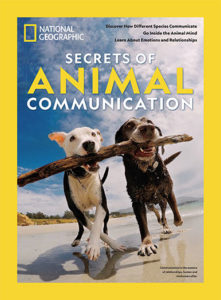 I was captivated recently by an article in National Geographic’s Secrets of Animal Communication. In particular, this passage on the first page really stuck with me:
I was captivated recently by an article in National Geographic’s Secrets of Animal Communication. In particular, this passage on the first page really stuck with me:
Communication might even be conceived … as anything that’s evolved to transmit information, with “information” defined as a reduction of uncertainty. Understood in this way, communication is found in the speckles on a trout’s flank and the courtship displays of whooping cranes, the abdomen-wagging dances of honeybees and – yes – monkey alarm calls … Cues, signals, messages – communication is everywhere, and life is a constant gathering of information.
A constant gathering of information, thereby reducing uncertainty. Amazing definition! At a very primal level, information is meant to reduce the unknowns, to guide us, to give us signals – via sight and sound – for knowing, deciding, engaging. Wow, let’s hold that thought for a minute.
When we gather information – in meetings and presentations – does it typically reduce uncertainty? Doesn’t it sometimes (or often) increase uncertainty? Obfuscate? Blur? Confuse?
What if we shared information only with the intention, or to the extent, that we would reduce uncertainty – or, to be more positive about it – to ensure certainty? Instead of giving in to the urge to be thorough or to prove that we’re the smartest person in the room, we would communicate – with our body language and our words – more deliberately and strategically, wouldn’t we?
We would indeed. So here are three of SmartMouth’s tips to help us be more deliberate and strategic with our information:
1. Cues. The best way to reduce uncertainty is to guide your audience each step of the way. Tell them when your introduction is over, when you’re making and concluding your first main point, when you’re digressing to tell a story, when you’re transitioning from one point to another, and when something you’re saying is more important than the rest. Drop little breadcrumbs along the way so they can track and know where you are and what they’re supposed to remember.
2. Signals. Decide that you’re going to show up, be present and let the audience know you want to be with them. If you make a conscious decision ahead of time that you’re going to relax and enjoy your time, it is more likely to happen and your audience is more likely to engage with you. And smile – it’s probably the best non-verbal signal you can send.
3. Messages. Information, defined as evidence, background or detail, is meant to support a point or message. Know your what your message is, and then, to support it, decide how much and what kind of information your audience can tolerate and digest … in order to reduce uncertainty. TMI, or too much information, is in the eye of the beholder, your audience! (Ask yourself: are they in the room by choice or obligation? If by choice, you have more latitude with info; if by obligation, limit it.)
Check yourself and be honest: Are you reducing uncertainty when you speak and share information or are you making the waters murkier for your audiences? We get a lot of wisdom about ourselves from our observations of the animal kingdom, but this particular gem, that info = reduction of uncertainty, is particularly poignant in a world of TMI. Like animals, our communication is via sight and sound, so let’s make sure we reduce uncertainty with both.
- New Agey Advice for Nervousness - November 3, 2022
- Your Passion Can Go a Long Way Toward Building Connection - October 10, 2022
- Keep stage fright a private matter while you’re speaking on a public stage! - August 11, 2022



